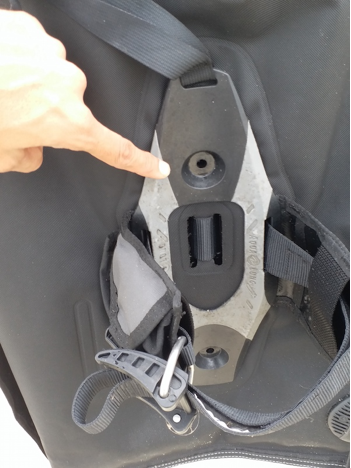Selecting A BCD – A Buyer’s Guide
By: Vandit Kalia
Buying a BCD and regulator is one of the major commitments divers make to the sport. It is a sign that they have dabbled around with other sports, but are now ready to settle down with the most awesome one of them all – scuba. And as with other commitments, there is always a bit of nervousness involved: am i making the right choice? Is this The One for me? Should I look around a little more and see if there is anything better? Will it be suitable in all dive conditions? Will we look good on the dive boat? Etc. etc. You get the idea.
If I had to pick, I’d prioritize gear purchase as follows: first priority: dive computer (safety). After that: mask, fins and/or wetsuit (personal gear that improves your comfort in the water). And lastly, BCD and/or regulator. Yes, last. As i said above, this is the commitment phase to diving.
What are the benefits of owning your BCD? First, cost. If you dive regularly, gear rental adds up very fast. Second, predictability and comfort. Having your own BCD means you know how much weight you need, how to distribute that weight, where the various releases and retainers are located and how much modulation you need to do to add/remove air. When that happens – when your hand automatically reaches over and gives the pull dump a quick tug for precisely that duration to adjust your buoyancy – then you are one step closer to reaching Scuba Zen.
The purpose of this article is to provide you with an explanation of the various features of a BCD, so that you can select one that is most suitable for your needs.
STYLES
There are 2 main styles of BCD:
– Jacket styles – these are the most common type of BCD, and the one that you probably did your Open Water training. The jacket wraps around your torso and contains the air bladder.
– Back inflation – here, the air bladder is entirely around the back, leaving your torso clear, except for some straps and webbing.
What is better? There is no clear answer, as each have their proponents. Jacket style BCDs are familiar and start at relatively affordable prices, are easy to manage for all swimming positions/trims and also have better surface stability.
Back inflation BCDs require a small adjustment in the water and more so on the surface, as they are not as stable in choppy seas, and have a tendency to push you face down in the water, especially if you over-inflate. However, they are also less restrictive around the body and many people, including me, find them more comfortable. Yes, there is a small learning curve to it, but it isn’t nearly as significant as opponents on back-inflation would make it seem: dont overinflate and learn to lean back a little while on the surface.
A lot of experienced divers prefer back-inflation for the in-water comfort (no restrictive bladder squeezing your torso) and greater ease of attaining horizontal trim (especially for wreck diving). That said, someone who is not too comfortable on the surface, especially in choppy seas and currents, may prefer a regular jacket style BCD, and these days, with trim pockets (more on that below), it is quite easy to attain neutral trim with jacket BCDs as well.
Backplate-and-wings are a more minimalist version of a back-inflation BCD, designed mainly for tech diving. More on these in a separate article.
Our recommendation – for someone starting out, a jacket or regular back-inflation BCD is a good buy. If you plan to get into tech or are diving regularly, then BP/wings may be worth considering. Feel free to contact us on sales@diveindia.com for advice on this.
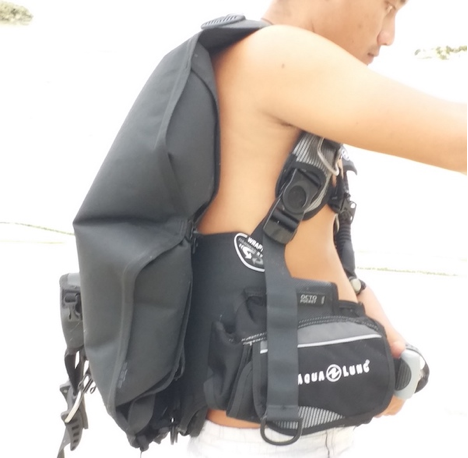
Back Inflation BCD – notice the air bladder in the back and relatively clean chest area, with only straps and pockets.
FIT / COMFORT
This is the most important feature of all. A good BCD is one that sits snugly and does not ride up on your torso when you are upright. This is also fairly easy to test – when you try on a BCD, make sure the velcro strap around the waist fits snugly. Once it is attached, try pulling the BCD up. It shouldn’t slide up. If it slides up to easily, or you have to tighten the velco all the way to the extreme ends in order to make it fit, it is too big. And obviously, if you cannot fit the BCD around your waist, it is too small.
If you are able to get a snug fit with some room on either side of the velcro band (ie, to tighten and loosen), then your BCD will be a good fit with most types of wetsuits as well. The shoulders dont need to be that tight – they should be snug enough that the BCD and tank dont flop back, but that’s about it.
An easy way to test this: put on the BCD, tighten the straps. Your chest should not feel squeezed, and if you or a friend grabs the top of the BCD and pulls up, the BCD should not rise up more than an inch or so.

A comfortable fit – snug around the waist, this BCD won’t rise up
The other thing that affects comfort is tank stability. A tank that constantly moves around or rises up (when empty) is just annoying enough to take away from the zen of being underwater. Here, BCDs with firmer backs and/or cut-outs for the tank are nice to have: these do a better job of holding the tank firmly against your back, no matter what your body position is or how much air the tank has.
The last thing is how structured the air bladder inside the BCD is. Some old-style “stab jackets” (stabilizing jackets) were virtually entirely air bladders inside – so the air pocket moved around a lot inside the BCD, and many people – myself included – hated that sensation. Modern jacket BCDs have more structure to the air bladders inside and so the air bubble doesnt move so much. Back-inflation BCDs have the entire air pocket on the back, and that does move around a little but because of the design, it doesnt affect stability.
STURDINESS / RELIABILITY
The main failure points of BCDs are the inflator hoses & inflator mechanism, usually to corrosion, sand getting caught inside or wear-and-tear. These can be swapped out. Resistance against abrasion depends on the outer fabric of the BCD – the cloth-like material. This is indicated by something called “denier count” – higher is better. You want 800-100 denier fabric for most of the BCD. This ensures that your BCD doesnt start to look faded/raggedy, and also prevents damage against being scraped against rough surfaces and such. Zippers are another failure point – they can get stuck, they can get torn, etc. This is harder to predict, but the better brands generally tend to be more reliable here.
QUICK DUMP VALVES
These are pull dumps which vent the air in your BCD rapidly – useful if you have lost your buoyancy and are going up at a faster-than-normal rate. Because this is a quick-dump, it is a lot faster than straightening up and using your inflator hose, thereby allowing you to check your rapid ascent more quickly.
At minimum, it is good to have one on the bottom of the BCD (around your waist/hips, when you have it on). That way, if you lose your buoyancy and are going up legs first, you don’t have to straighten up and get head-up before you can vent. And one neat little benefit of this: once you are used to this and know the rate at which these valves vent air, you may be able to use these for minor adjustments (which is a lot more convenient than straightening up and using your inflator hose each time.
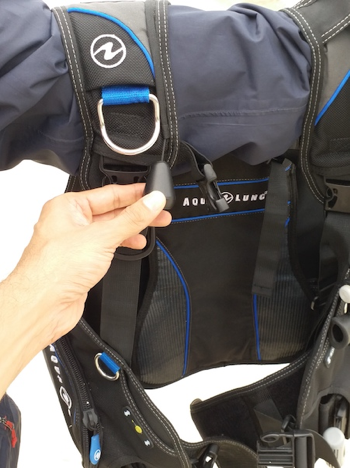
Upper Quick Dump
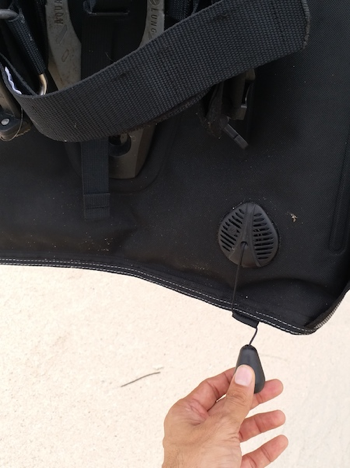
Bottom Quick Dump
It is also nice to have a dump valve up high – around the shoulders – for times when you are going up in a vertical, heads-up position. Strictly speaking, you can manage without it – in this position, you can always use your normal inflator/deflator. But the dump valve is faster and not prone to positional errors with the inflator hose, and so is a better solution in a stressful situation (and a rapid ascent most definitely IS that).
Some BCDs combine the regulator inflator/deflator hose with a pull dump – in other words, instead of raising the hose over your head to release air, you can simply tug on it and it acts like a quick dump valve. Those work too – and have the benefit that you dont need to fumble around and find out where the pull dump cords are located
INTEGRATED WEIGHT POCKETS
Integrated weight pockets are exactly what the name implies – pockets where you can store your weights, as opposed to putting on a belt. And as with all weights, these are quick-release: ie, easy to ditch in an emergency.
These are super-convenient in several ways. For one, you no longer have to deal with weights sitting on your hip bones or the small of your back – so more comfortable. Second, because there are 2 pockets, ditching weights is no longer and all-or-nothing proposition. You can ditch half your weights, if need be: which means your ascent will be more controlled. Third, they are easier to ditch than a weight belt, which is often hidden under your BCD and its velcro waistband.

Integrated weight pockets feature a QR handle – just grab and pull to ditch the weight
TRIM POCKETS
I would not buy any BCD without trim pockets and neither should any diver looking to really fine-tune his/buoyancy, in my opinion. Trim pockets are basically small weight pockets higher up on the BCD – around your shoulders or upper back, where you can put 0.5-2kg worth of weights (this is a non-ditchable pocket, so be careful not to overload these). What this does is raise your center of gravity even higher: this pulls your head down and legs up. By adjusting the distribution of weights in the trim pockets, integrated weight pockets and even weight belt (if need be), you can find the right balance at which your center of gravity and your center of buoyancy coincide. At that point, you can hold whatever position you want in the water
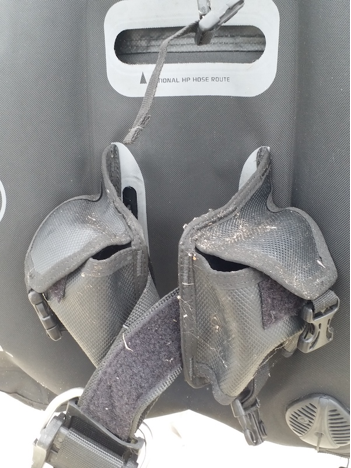
Integrated weight pockets feature a QR handle – just grab and pull to ditch the weight
And that’s the way you need to be: being perfectly flat is great for when you are wreck diving or looking for macro critters. But on most reefs, there are times when you want to be slightly heads up to look for mantas in the blue or hammerheads (if you really believe they exist!). There are also times when you want to be legs up – eg, when you are close to reefs and look at something under a rock. And you should be able to hold each of these positions effortlessly and without struggling – and that’s why you need to have neutral trim.
Once you actually attain neutral trim, you will be spoiled for life – diving will become truly zen-like when you are not expending ANY effort in maintaining your body positioning. And once you get to know that feeling, even half a kg more or less starts to feel “wrong” and you too will swear by trim pockets.
POCKETS AND D-RINGS
I did my tech dives with no pockets and 3 D-rings. I had my 2 lift bags bungeed up under my twin sets. My reel was hanging on a D-ring on the crotch strap. My stage bottles were clipped to the two D-rings on my left shoulder. Now that i am mostly doing recreational dives, I prefer to have a pocket – i can keep a small finger reel, a safety sausage and a slate in there. It is far more convenient than having stuff strapped all over my body.
So yes, a pocket is nice to have for recreational diving. Thankfully, virtually all BCDs have a couple of them. D-rings – you dont need too many. Many divers i see are festooned like a Christmas tree, with stuff hanging on them. If that floats your boat, go for it. But generally speaking, a couple of D-rings is more than sufficient for virtually all the gear you will carry as a recreational diver. And again, most BCDs have them.
One very small feature that I am a big fan of: a built-in retainer for the octopus. In this day and age, it is absurd that one has to buy a separate accessory just to clip in the octopus. On some BCDs, you can fold the hose and tuck it into the shoulder (my favorite position). On others, you have a built-in hose retainer which keeps the octo in place and prevents it from dragging.
This is the cup-holder equivalent for BCDs: a minor thing, but it pays off on each dive.
ADEQUATE LIFT
For people diving in tropical conditions, with a thin (3mm) wetsuit that doesn’t have a lot of buoyancy, this isnt an issue. But consider cold water diving. Let’s say you are wearing a 7mm suit with a 5mm shorty on top, in order to dive in cold water. For this, you need, say, 12kg of weight, plus whatever you need for your body type. You get to the bottom and your wetsuit compresses and loses most of its buoyancy. So now you are 12kg negatively buoyant. Some tropical BCDs only have 8-9kg of lift. So even if you inflate this BCD entirely, you will be 2-3kg negatively buoyant. Problem? You bet.
So it is good to make sure your BCD has enough lift – even if you are not diving in cold water, it is helpful to have that if you are caught in a down-current, for example.
SIZE / WEIGHT
For those of you looking for something light to travel with, many brands these days have ultra-light travel BCDs. These minimal designs have reduced padding and fabric, smaller tank cutouts/back frame and fold up into a very compact package for travel.

Travel BCDs like the Zuma are light and fold up into a very small package
WOMEN SPECIFIC DESIGNS
It may come as no surprise that women’s bodies are slightly different from men’s. Women typically tend to have shorter torsos than men, and the curves/shapes are different as well. It is a frequent complaint among female divers that a typical BCD is not as comfortable, either tending to ride up or the straps digging into their chest.
Thankfully, most brands make BCDs in women-specific designs. These are contoured and padded differently in order to better fit a woman’s torso, and the straps are designed in a way that they increase comfort

The padding and straps of a WSD design
UNUSUAL FEATURES
The recreational BCD design has been pretty standardized over the past 25-30 years. Non-typical designs often tend not to fare as well, mainly because they are different and not what people are used to. And there are grouchy old-time instructors who go “well, this was good enough back in my day when dinosaurs roamed the earth and gosh darn, it is good enough for my students as well”. I find myself falling in this category and have to force myself to be open-minded about change.
Most of the major brands will have atleast one or two products which are on the cutting edge of technology and design. For example, Aqualung has the i3 inflator mechanism which replaces the traditional inflator hose with a level around the waist – this can be moved up or down to add/remove air.

i3 inflator/deflator mechanism (still sealed), with the hose attachment point above it
Whether or not you want these features is a personal thing. On one hand, reputable manufacturers dont simply put in features (especially on safety-crticial gear) unless they are confident that these features will be beneficial. On the other hand, there is the downside: greater cost, increased complexity of servicing and sometimes, even manufacturers screw up, despite the best of intentions.
So how do you decide? Ask yourself if the feature actually has any tangible benefits to your diving, and if so, are those benefits worth the asking price. Do some research from people who have used this product and get their feedback. Ask your instructor or dive center for advice. And then make a decision.
For example: I know that when i buy a replacement recreational BCD for myself, I plan to get one with the i3 feature because it actually matches how i deflate my BCD when i am diving (I use my rear emergency dump valve). And not having another hose dangling when i dive is a big plus. However, there are other innovations i wont touch, because they dont provide me with any appreciable benefits and/or are not suitable for my style of diving (eg, split fins).
IN CONCLUSION
So there you have it – a list of things to look for and compare, when buying a BCD. Ultimately, a BCD should do the following things:
– It should hold the tank securely and against your back
– It should fit comfortable and not ride up on your body
– It should have adequate lift to provide you buoyancy in all your diving conditions
– It should have attachment points for all your gear
– It should allow adjustment of trim to match your wetsuit/tank/body type combo
– It should be sensibly designed for comfort, stability, reliability & ergonomics
Hopefully, this article lets you assess how to evaluate each BCD along the above criteria.
If you are looking to buy a BCD, please email us on sales@diveindia.com. We are also happy to discuss your requirements with you and help you figure out the best BCD for your requirements.
As dealers of Aqualung, Mares and Scubapro gear, we can source a full range of their models, although we primarily stock only select BCDs from these lines, which we feel offer better value for money. While we cannot always match online prices, we do try to come close and hope that the personalized advice, options to try-before-you-buy and the benefit of local sales/service makes up for the remaining minor difference.
The author is the founder of DIVEIndia Scuba & Resorts, a NAUI Course Director and SSI Instructor Trainer. He has been teaching since 2001 and has certified over a thousand students, from Open Water to Instructor.


